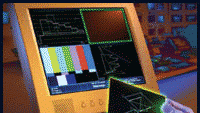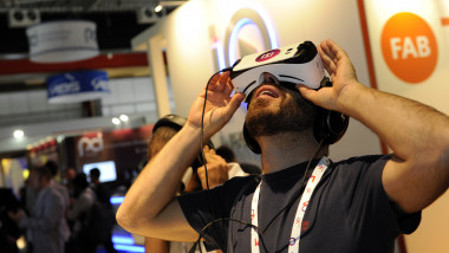Tektronix’s WVR600 series rasterizers
Signal monitoring is necessary at many places throughout the workflow process of video and audio content production. Users of monitoring devices range from extremely experienced engineers/technicians to the other extreme of editors and colorists who need uncluttered displays and alarms, largely to tell them when technical limits are being reached or exceeded.

The WVR600 series rasterizers support SD-SDI and hybrid SD-SDI/Composite applications in a 1RU form factor.
As more program production is being outsourced to independent producers, more stringent standards are placed on post houses to conform to clients’ requirements. As a result, quality control is essential throughout the production process. Also, with an ever-increasing number of program channels being transmitted, even the transmission playout duty engineers need semi-automated equipment to monitor the conformance of incoming or outgoing signals.
Monitoring equipment takes many forms, but of high importance is the familiarity of displays representing the video and audio signals. In the past couple of years, Tektronix incorporated a rasterized display in its WFM700 SD/HD signal monitor, offering the advantage of replicating the selected WFM700 signal representation on an external SVGA display.
The company’s newest addition to its signal monitoring range is the WVR600 waveform rasterizer. “Rasterizer” often generates questions (and even some suspicion), but once the term is explained, its operational benefits are clear.
Rasterization techniques in various forms have been with us for a while now and cannot be termed a new concept in strict engineering terms, but their entry into the operational marketplace has been less speedy than it otherwise might have been for a number of reasons. Traditional users’ adherence to tried and trusted monitoring equipment is high amongst those factors.
Conventional X/Y-driven, CRT-based equipment is always liable to inherent errors and limitations in accuracy, linearity and temperature drift. The nature of the shared beam and the inescapable fact that it needs to drop away from waveform scanning to “draw” any text on screen also can lead to display-quality compromises, particularly regarding the legibility of text content. Finally, the analog nature of the CRT display and scanning elements also necessitates digital to analog conversion and can thus further increase the potential for errors.
The professional video industry's #1 source for news, trends and product and tech information. Sign up below.
Rasterization allows a completely digital solution with all its inherent advantages. Whilse conventional devices are prisoners of their CRT and X/Y (vector-based) scanning systems, the rasterized solution allows display on a high-resolution SVGA monitor with clear text resolution, as well as multiple fonts and colors. Because any graticule information exists in the same display plane, any viewing parallax error is also eliminated.
The WVR600 series is a good starting point to explain the virtues of rasterization and lay to rest some of the ghosts that have haunted the concept in the past. The series is based on a 1U rack-mount format. It provides 1024x786 XGA output for a remote VGA display, which can be located remotely from the base unit placed according to the workspace requirements. This 1U design is the first departure from the integral-display 4U box with which we are all familiar. The pressure on installations for more compact products, particularly in the outside broadcast domain, and the fact that the series is designed to remotely feed a computer SVGA monitor or TFT display, allows a completely different approach.
A summary of audio errors is combined with level bars and Lissajous, picture monitor and vector.
The principle of rasterization in which the entire raster screen is refreshed every cycle allows the device to be completely digital in its processing, thus immediately eliminating temperature and linearity error. Text display is now sharp, legible and configurable and can easily coexist with any waveform display without compromise. The input signal can be displayed in a number or combination of different ways, thus giving added confidence of measurement and more precision.
Users look for fundamental measurements and frequently operate in an environment where percentage error is acceptable, so what advantages can rasterization technology offer? To begin with, the rasterized display can provide the same easily-understood displays required in such circumstances. It can be displayed in a form that is more legible, on a choice of different display sizes and types for viewing at a distance, and can be displayed with the addition of color elements to visually highlight specific signal features. Simultaneous text display improves comparative accuracy, and the resulting XGA output can be replicated on external displays across a number of locations to suit the users.
The series also introduces a new display capability, FlexVu. This allows users to create a flexible, multiple display of the four most vital signal representations that most regularly suit their needs. Waveform, vector, gamut, status and picture displays of the selected signal can be selected in any of the display quadrants, incorporating the expected line select, gain and magnification features. Thus, the most relevant parameters can be viewed together on the display at the same time, and adjusted accordingly, accompanying audio can also be displayed if the necessary option is fitted.
When necessary, a simple button press will immediately restore any of the displays to full screen for closer scrutiny. For example, dual waveform and vector displays can be configured in conjunction with picture representation of the source video. Alarm configurations can also be set up, and via its built-in remote control capability, errors can be captured and time-stamped, logged to an external PC and even sent by Internet for further examination or analysis elsewhere if necessary.
Equally useful in a post suite, a combination of traditional waveform or vector displays can be combined with Tektronix’s color gamut displays to warn of signal color validity being violated. Once again, the alarm capability is invaluable in this less technical environment and can be pre-configured by the technical staff. The series also incorporates a new display to simplify the task of system timing by presenting a unique crosshair screen with numerical readout. Timing differences between signals are displayed as horizontal and vertical displacements from the center. This allows an engineer to quickly correct timing error or to time complex systems with relative simplicity by simply adjusting system parameters until the crosshairs are overlaid. These adjustments are time-consuming and critical, so this is yet another indication of the novel approaches that can be applied to specific problems.
To summarize, when viewed in purist technical terms, the rasterized option is significantly more accurate than the best of its CRT equivalents. It is operationally as flexible, and in its current implementation, it is much more flexible for all applications. Early attempts at rasterized displays may have left engineers with the impression that such technology is a mere gimmick, but like all good ideas, it has evolved beyond that to become a new and vital tool for accurate and repeatable measurement.
Configurable for digital-only or combined analog/digital video environments plus optional digital/analog audio capability, the WVR600 series enshrines the opportunities in this now maturing technology. CRT display technology has the benefit of legacy and familiarity, but in today’s digital world, we would be foolish not to embrace the more cost-effective and flexible opportunities that new rasterized technology offers.
Paul Dubery is the European marketing manager for Tektronix Video Segment.
